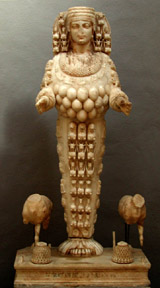Cult Of Artemis


The Cult of Artemis is the one you want eh? A very good choice. This cult is the largest and most powerful for the time in Ephisos. Just about everyone follows Artemis, so no matter what, you have little to worry about in religious problems. Your temple was founded in the 7th Century, although the cult dates past that, and is quite possibly the most beautiful structure on Earth during this time. Now, lets learn about about who you're worshiping, where and how.
Artemis: Great Mother and Divine Huntress
Artemis, in Greek mythology, was the daughter of the god Zeus and Leto and the twin sister of the god Apollo. She was chief hunter to the gods and goddess of hunting and of wild animals, especially bears. Artemis was also the goddess of childbirth, of nature, and of the harvest. It is believed that she was first this caring earth mother goddess (as she is worshipped in Ephisos) and later after many religious changes became the virgin huntress of myth. She was also a moon goddess, and was sometimes identified with the goddesses Selene and Hecate. The huntress Artemis was often depicted with a stag to show her wildness and freedom in the hunt as well as with a bow and quiver proving her to be a huntress. The mother Artemis is often depicted with numerous breasts and is surrounded by numerous wild animals to show her as the nurturing mother of everything (see the image above). (1)
(3)
Rituals
The greatest ritual acted out by the Cult of Artemis is the procession of statues. This procession was first created by Salutaris in 104 A.D. and was to have "no relation to any sacraments of Artemis" since a procession of this scale was meant for emperors and those returning from a victory. To signify this, no meat was sacrificed to the Goddess, thus keeping it from being a "sacrament". The procession itself, however, was a train of 31 statues, thirty of which were made of silver and the last of silver and gold. Of these 31 statues, nine were of the goddess Artemis alone (the only immortal to appear in the procession), one of which was the only golden statue. The golden statue was of Artemis the Huntress depicted with a stag and her bow with quiver. This statue led the procession and although it was the only one of gold, it often didn't stand out during the procession. The most apparent statue in the procession was of Artemis carrying a giant lit torch (similar to the image in the stone relief above) which would shine brightly as the procession move through dusk into the night. The other seven statues also contained various iconography associated with the cult and acted to promote the following of Artemis. The other statues, those not of Artemis, were of various important Romans(emperors, nobles, etc.) as well as of people within various mythology. (one of which was Leto, the mother of Artemis.) The Procession would begin in front of the glorious Temple of Artemis, from which the statues would be removed. The statues were then carried by the priests of Artemis and temple guards along the Sacred Road in through the Magnesian Gate. There the procession would go past the Tomb of St. Luke, through the major portions of the city and ultimately back to the temple of Artemis. Now, although this was proclaimed a "civic ritual" and the people did not protest it, the Procession was filled with obvious iconography showing favor for the Cult of Artemis and thus was later decided to be a ritual of the temple, although still called a "civic" ritual.(9)
The Temple of Artemis
(2)
One of the most spectacular sights of the ancient world (and later deemed one of the 7 wonders of the ancient world) was the Temple of Artemis at Ephisos. It was built by the Lydian king Croesus in 550 B.C. and was designed by the Greek architect Chersiphron. The foundation of the temple was rectangular in form, similar to most temples at the time, however, unlike the other temples, the building was made of marble, with a decorated fašade overlooking a spacious courtyard. Marble steps surrounding the building platform led to the high terrace which was approximately 260 ft in length by 430 ft in width. The columns were 60 ft high with Ionic capitals and carved circular sides. There were 127 columns in total, aligned orthogonally over the whole platform area, except for the central cella or house of the goddess. (2) On July 21, 356 BC, a man named Herostratus burned the temple to ground in an attempt to immortalize his name. Strangely enough, Alexander the Great was born the same night. Later the Roman historian Plutarch wrote that the goddess Artemis was "too busy taking care of the birth of Alexander to send help to her threatened temple". Over the next two decades, the temple was restored and when Alexander the Great conquered Asia Minor, he helped rebuild the destroyed temple. The newly rebuilt temple was filled with various pieces of art, including finely crafted bronze statues and unique paintings as well as jewelry and other valuables for the goddess Artemis.(2) The temple was a major center for activity for the entire city. It served as both a marketplace and a religious institution, and was frequently visited by merchants, tourists, artisans, and kings who paid homage to the goddess by sharing their profits with her. Often vendors could be found selling miniature statues of Artemis to worshipers or to those who had just come to see the temple.(9) The temple was also the start and finish of the Procession of statues, as well as the holding place for the statues. Since it was a major meeting place within the city, and very important to the city's heritage, the citizens were often quite loyal to it and the Goddess Artemis, which would cause problems for early Christianity later.